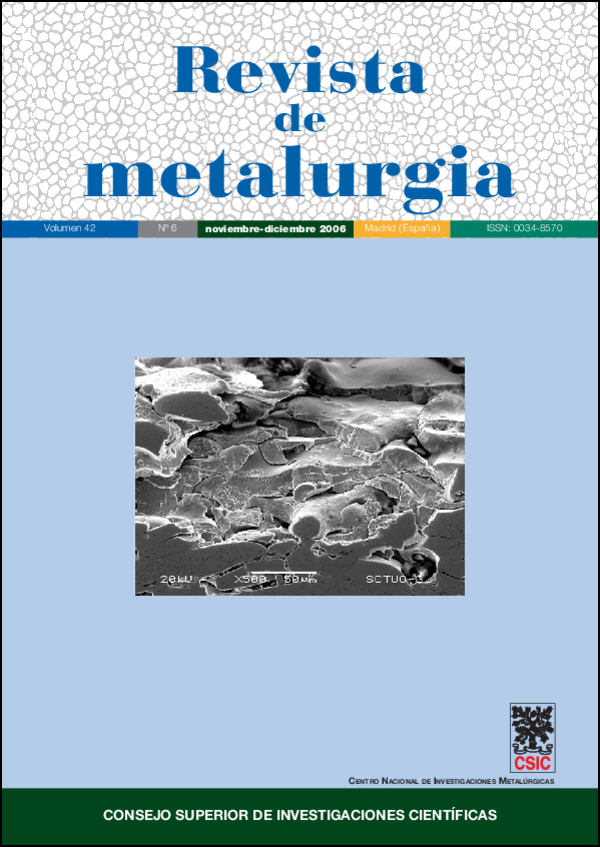Stabilization of MgCr2O4 spinel in slags of the
SiO2-CaO-MgO-Cr2O3 system
DOI:
https://doi.org/10.3989/revmetalm.2006.v42.i6.40Keywords:
Spinel, SlagAbstract
El objetivo de este estudio es analizar el efecto del contenido de MgO y la basicidad de la escoria sobre la estabilidad de las especies mineralógicas del sistema de escoria SiO2-CaOMgO-
Cr2O3. Se realizaron ensayos al equilibrio a 1600 °C bajo condiciones reductoras (pO2=10-9atm). El contenido de MgO fue de 0 a 12 % masa, el Cr2O3 de 10% y la basicidad de 1 y 1,5. También se realizó un análisis termodinámico para determinar las fases mineralógicas más estables en la escoria. Los resultados experimentales y calculados muestran que el Cr2O3 se encuentra principalmente ligado en una fase espinela MgCr2O4, incluso a bajos contenidos de MgO. Los resultados obtenidos por microscopia electrónica de barrido (MEB-EDS), muestran la evidencia de tres estructuras cristalinas: (A) Octaedros, los cuales
corresponden a la espinela MgCr2O4, (B) Cristales alargados que corresponden a la formación de silicatos cálcicos y (C) Matriz de silicatos cálcicos con impurezas de Mg y Cr que no cristalizaron por completo.
Downloads
References
[1] Q. Ying, N. Holemberg, N. Menad and B. Björkman, Proc. 58th Electric Furnace Conference, The Iron and Steel Society, 2000, pp.195-207.
[2] European Comission. Technical Steel Research, Final Report. Ref. 7210-CB/124, 125, 415, 942. (1995-1998).
[3] M. Gornerup and A.K. Lahiri, Ironmaking Steelmaking 25 (1998) 317-324.
[4] J. Gutiérrez-Paredes, A. Romero-Serrano, B. Zeifert and V. Arredondo-Torres, Steel Res.Int. 76 (2005) 764-768.
[5] J. Gutiérrez-Paredes, A. Romero-Serrano, M. Angeles, F. Chávez and B. Zeifert, Rev. Metal. Madrid, Vol. Extr. (2005) 443-446.
[6] H. Shen, E. Forssberg and U. Norstrom, Resources, Conservation & Recycling 40 (2004) 245-271. doi:10.1016/S0921-3449(03)00072-7
[7] P.T. Jones, J. Vleugels, I. Volders, B. Blanpain, O. Van Der Biest and P. Wollants, J. European Ceram. Soc. 22 (2002) 903-916. doi:10.1016/S0955-2219(00)00343-5
[8] E.B. Pretorius, R. Snellgrove and A. Muan, J. Am. Ceram. Soc. 75 (1992) 1378-1381. doi:10.1111/j.1151-2916.1992.tb04197.x
[9] S. Jahanshahi and S. Sun, Proc. Yasawa Int. Symp., The Minerals, Metals and Materials Society. Vol. 1, 2003, pp. 227-244.
[10] W.T. Thompson, C.W. Bale and A.D. Pelton, FACTSage-Facility for the Analysis of Chemical Thermodynamics, User’s Manual, 2004.
[11] A.D. Pelton and M. Blander, Metall. Trans. B 17 (1986) 805-815. doi:10.1007/BF02657144
[12] Z. Panek and E. Kanclir, Ber. Dtsch. Keram. Ges. 47 (1970) 431-434.
[13] Y. Xiao, L. Holappa and M.A. Reuter, Metall. Trans. B 33 (2002) 595-603. doi:10.1007/s11663-002-0039-9
[14] M. Tanahashi, N. Furuta, C. Yamauchi and T. Fujisawa, ISIJ Int. 41 (2001) 1309-1315. doi:10.2355/isijinternational.41.1309
[15] C. W. Chesterman and K.E. Lowe (Eds.). The Audubon Society. Field Guide to North American Rocks and Minerals. Alfred A. Knopf, Inc. New York, U.S.A., 1988, pp. 416-419.
Downloads
Published
How to Cite
Issue
Section
License
Copyright (c) 2006 Consejo Superior de Investigaciones Científicas (CSIC)

This work is licensed under a Creative Commons Attribution 4.0 International License.
© CSIC. Manuscripts published in both the printed and online versions of this Journal are the property of Consejo Superior de Investigaciones Científicas, and quoting this source is a requirement for any partial or full reproduction.
All contents of this electronic edition, except where otherwise noted, are distributed under a “Creative Commons Attribution 4.0 International” (CC BY 4.0) License. You may read the basic information and the legal text of the license. The indication of the CC BY 4.0 License must be expressly stated in this way when necessary.
Self-archiving in repositories, personal webpages or similar, of any version other than the published by the Editor, is not allowed.
















